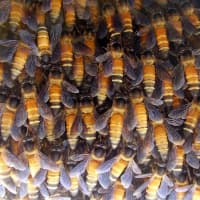Tualang Honey is a multifloral jungle honey found in Malaysia.[1] Tualang Honey is produced by the rock bee (Apis dorsata), which builds hives high up in the branches of Tualang tree (Kompassia excelsa).[1:1] The Tualang tree (common name Mengaris) can reach up to 250 feet in height. The honeycombs can be up to 6 feet across, and the hive can contain as many as 30,000 bees.[1:2] More than 100 nests may be found on one Tualang tree. Such a tree can yield some 450 kg (about 1000 pounds) of honey.[1:3]
Composition
A total of six phenolic acids (gallic, syringic, benzoic, transcinnamic, p-coumaric, and caffeic acids) and five flavonoids (catechin, kaempferol, naringenin, luteolin and apigenin) are found in Tualang Honey.[1:4]
Hydrocarbons constitute more than half (58.5%) of its composition. These include alcohols, ketones, aldehydes, furans, terpenes, flavonoids, and phenols.[1:5]
Some compounds found in TH previously not reported in other honeys are stearic acids, 2-cyclopentene-1,4,-dione, 2[3H]-furanone or dihydro-butyrolactone, gamma-crotonolactone or 2[5H]-furanone, 2-hydroxy-2-cyclopenten-1-one, hyacinthin, 2,4-dihydroxy-2,5-dimethyl-3[2H]-furan-3-one, and phenylethanol.[1:6]
Healing Properties
Anti-Aging
Antimicrobial
Antibacterial
Tualang Honey has both bactericidal and bacteriostatic properties against a range of bacteria, including common bacteria on the skin.[1:7]
In general, it is as effective as Manuka honey against several bacterial strains.[1:8]
At concentrations of 6.25–25%, Tualang Honey inhibits the growth of several bacterial strains, such as Streptococcus pyogenes, Salmonella typhi, Staphylococcus aureus, coagulase-negative Streptococcus spp., and Escherichia coli.[1:9]
Antiinflammatory
Antioxidant
Honey has antioxidant activities that can suppress oxidative stress.[1:10] The antioxidants in honey are flavonoids, phenolic acids, amino acids, proteins, and some enzymes.[1:11]
Tualang Honey has similar antioxidant activity to Manuka honey, Slovenian honey and other honeys.[1:12]
Tualang Honey alone or in combination with glibenclamide and metformin protects against oxidative stress in streptozotocin-induced diabetic rats.[1:13]
Tualang Honey has a higher level of antioxidant activity than other local Malaysian honeys, such as Gelam, Indian forest, and pineapple honeys.[1:14]
Based on a study of nine different Malaysian honeys from different origins (using Manuka honey as gold standard), Tualang Honey has more free-radical scavenging and antioxidant activity than other local and commercially available honeys.[1:15] This was attributed to its high content of phenolics and flavonoids.[1:16]
Antimutagenic
Antitumor
Tualang Honey shows antiproliferative or antitumor activity against various types of cancer cells, exhibiting antiproliferative and early apoptotic effects against oral squamous cell carcinoma, human osteosarcoma cell lines, human breast cancer MCF-7 cells and cervical cancer cell lines at concentrations of 1–20%.[1:17]
Tualang Honey seems to have promising antitumor activity related to its high content of phenolic and flavanoid antioxidants.[1:18]
Antidiabetic
Tualang Honey has an intermediate glycaemic index based on tests in healthy individuals.[1:19]
Tualang Honey modulates the glucose level according to studies comparing the effect of Tualang Honey and the oral hypoglycaemic agents glibenclamide and metformin on streptozotocin-induced diabetic rats:[1:20]
- The diabetic rats were randomised into six groups and administered distilled water, honey, glibenclamide alone, glibenclamide and Tualang Honey, metformin alone or metformin and Tualang Honey.[1:21]
- Tualang Honey significantly increased insulin levels (0.41 +/– 0.06 ng/ml) and decreased hyperglycaemia (12.3 +/– 3.1 mmol/L) and fructosamine (304.5 +/– 10.1 mmol/L).[1:22]
- Although glibenclamide or metformin alone significantly (P < 0.05) reduced hyperglycaemia, glibenclamide or metformin combined with Tualang Honey resulted in a significantly lower blood glucose level (8.8 +/– 2.9 or 9.9 +/– 3.3 mmol/L, respectively) compared to glibenclamide or metformin alone (13.9 +/– 3.4 or 13.2 +/– 2.9 mmol/L, respectively.[1:23]
- These results indicate that a combination of oral hypoglycaemic agents with Tualang Honey improves glycaemic control in diabetic rats.[1:24]
Wound-healing
Tualang Honey is more effective than Manuka honey against some gram-negative bacterial strains in burn wounds management, probably due to its higher content of phenolics, flavanoids, and Hydroxymethylfurfural.[1:25]
Tualang Honey reduces the growth of wounds infected with Pseudomonas aeruginosa, Acinetobacter baumanii or Klebsiella pneumonia, with one study reporting superior healing with a honey dressing than with conventional silver and aquacel dressings.[1:26]
- These bacteria are a common cause of hospital infections.[1:27]
In general, honey improves wound healing by abating the oedema, inflammation, and exudation that commonly occur in all types of wounds.[1:28]
Honey stimulates the growth of epithelial cells and fibroblasts. [1:29]
Tualang honey heals moist burns and several other types of wounds.[1:30]
In full-thickness burn wounds treated with Tualang Honey and conventional hydrofibre silvertreated wounds, the wounds treated with the Tualang Honey show a reduction in wound size of 32.26%.[1:31]
Wound healing in Tualang Honey-impregnated dressings are comparable to those obtained with modern hydrofibre and silver dressings.[1:32]
Patients prefer Tualang Honey hydrogel dressings than conventional dressings because the treatment is soothing, they experience minimal pain and the dressings have a pleasant odour.[1:33]
Diabetic Foot
Tualang Honey is as effective as Manuka honey in the treatment of diabetic foot.[1:34]
Cardiovascular Health
Tualang Honey has the potential to reduce cardiovascular risk factors in healthy individuals.[1:35]
Blood Pressure / Hypertension
Tualang Honey decreases systolic blood pressure.
- Improves hypertension [1:36]
Triglycerides / Cholesterol
Tualang Honey reduces levels of triglycerides and very low density lipoprotein (VLDL).[1:37]
Disease / Symptom Treatment
Title: Review of the Medicinal Effects of Tualang Honey and a Comparison with Manuka Honey
Publication: The Malaysian Journal of Medical Sciences
Date: May 2013
Study Type: Review
Author(s): Sarfarz Ahmed and Nor Hayati Othman
Institution(s): Department of Pathology, School of Medical Sciences, Universiti Sains Malaysia, 16150 Kubang Kerian, Kelantan, Malaysia
Copy: archive, archive-mirror ↩︎ ↩︎ ↩︎ ↩︎ ↩︎ ↩︎ ↩︎ ↩︎ ↩︎ ↩︎ ↩︎ ↩︎ ↩︎ ↩︎ ↩︎ ↩︎ ↩︎ ↩︎ ↩︎ ↩︎ ↩︎ ↩︎ ↩︎ ↩︎ ↩︎ ↩︎ ↩︎ ↩︎ ↩︎ ↩︎ ↩︎ ↩︎ ↩︎ ↩︎ ↩︎ ↩︎ ↩︎ ↩︎
